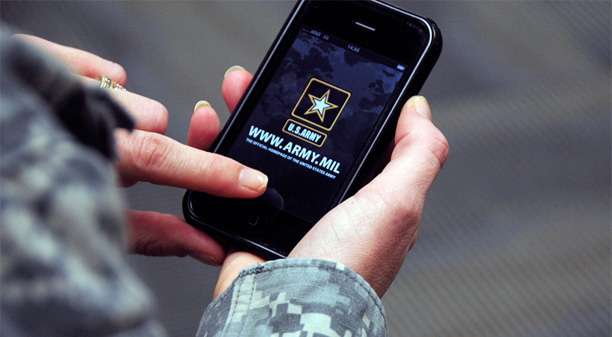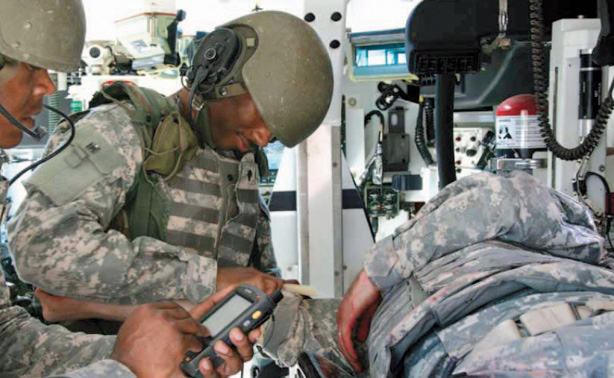The latest advances in mobile technology and the impact these technologies have on affecting military operations are the focus of Mr. Peeter’s expertise this month.

The U.S. Department of Defense (DoD) recently approved Enterprise Service 10 on BlackBerry’s Z10 and Q10 smartphones, PlayBook tablets and Samsung’s Galaxy S4 Knox. The Pentagon has 470,000 BlackBerry users, 41,000 Apple users, and 8,700 people with Android devices—this announcement places the military use of mobile phones under the spotlight.
The reality is that military command personnel have used commercial off-the-shelf (COTS) comms solutions ever since they became available to consumers. In my experience, commanders will tell you that without these devices, they’d be stuck. If they’re assigned to a reconnaissance mission and find themselves outside of radio range without an operator in their patrol, how do they send their information back to base? Satellite phones are a luxury and not easy to procure, so they get out their Blackberry/iPhone/Android device and make a phone call.
Unencrypted data flows unimpeded through the mobile networks, into the carrier’s’ servers and then back out to the receiver. Risks include phones being lost or stolen by the enemy, and system denial (a mobile carrier’s signal is either there or not—if an insurgent blows up cellular ground masts, then the carrier is indefinitely out of action).
What happens when a phone is lost? The data that resides on it could compromise the owner, or even an entire mission. Blackberry and Samsung recognized this and their latest technologies partition the devices they’re installed on—one half of the device is for personal use, the other for business or military use. In this way, militaries can allow personnel to use their mobile devices for personal use, secure in the knowledge that what is on the device is encrypted, backed up, and can be remotely wiped, if compromised.
Other dangers include the ability to triangulate cellular phones using ground masts and the inability to include them in a concept of operations (conops) due to their potential for disruption. Satellite devices will always work wherever they’re being used; they can be relied upon and used for mission planning. Mobile phones cannot and, therefore, can never act as anything more than a first responder accessory. However, the increased capability they afford is significant and worth examining in closer detail.
Readymade Architecture
Cellular networks (GSM/EDGE technology) cover 85 percent of the world’s population. Ericsson predicted last year that the same percentage will have access to high speed WCDMA/HSPA networks by 2017. They are ready made comms backbones and are wide ranging. They’re maintained by multi-billion dollar private companies with extensive resources.
However, most importantly from a military perspective, they’re already in place. When a force enters a new territory, it has to build a radio network using power units and relays. While this is an essential long term comms investment and a key part of any military deployment, it is not suitable for first responders. This leads neatly to the second point.
Risk Vs. Capability
A comms capability is obviously required when entering a region. While a commercial cellular network may not be as secure as combat network radio, it offers good voice and data capability. Commercial devices are also essential for covert operations. Pulling out a combat-net radio will surely blow a soldier’s cover, while a Blackberry or similar smartphone goes unnoticed. This is symptomatic of the war among the people our allied forces are now fighting. While the cellular networks remain vulnerable, they can be used to maintain personnel safety and afford crucial first responder comms capability.
Another advantage of cellular networks is communications interoperability. I’ve personally experienced situations in which an allied helicopter couldn’t communicate with a military vehicle 30 feet below it because they weren’t carrying the right encryption keys, or were using the wrong type of UHF/VHF radio (for example, police tetra radios aren’t compatible with their military frequency equivalents). Whereas, personnel from multiple forces using a commercial cellular network know they’ll be able to communicate with one another and will be able to acquire the correct devices to do this subtly, and at short notice. This is an advantage that should not be underestimated.

Medical Communications for Combat Casualty Care (MC4). Photo courtesy of L-3 Communications.
Security
While commercial cellular networks are vulnerable, the data that travels over them does not need to be exposed to interception. Secure apps designed to send AES256 encrypted positional data, text messages, emails and telemetry over commercial networks already exist and can be downloaded from the App Store or Google’s equivalent, the Play Store.
If the nature of a mission changes and a first responder needs to provide their commanders with command and control capability for example, then they can realistically download an app from the relevant store and instantly start using it. Apple’s App Store model was recently praised as the ‘biggest security innovation of the last 10 years,’ according to Mikko Hypponen, chief security researcher with F-Secure.
There has never been a reported instance of malware, and the apps all go through testing and approval processes. This means militaries have two options: Form partnerships with the commercial app store manufacturers to supply troops with secure access to apps on the move, or, build their own app stores. Inevitably the second option will win out as it offers a higher level of control, however, it also requires greater commitment to expensive R&D and will require time to build.
In order to meet urgent operational requirements, we envisage a future in which forces can select from a range of applications dependent on the mission at hand, all designed to securely transmit encrypted military data over cellular networks. In the early days of the Iraq war, plain clothes soldiers were parachuted into Fallujah. Imagine if these first responders were able to download software applications onto their smartphones as the mission developed—applications that would allow commanders to build a common operational picture and coordinate the undercover force securely. This could be done safely with the knowledge that, even if a device was compromised, it would be unbreakable and could be remotely wiped at the touch of a button. The extra capability surely outweighs the risk.
Server Solution Sovereignty
RIM realized that enterprises wanted greater messaging control and introduced the Blackberry Enterprise Server (BES) solution to give companies control over their messaging and data flow. But the BES wasn’t a server at all; it was software that sat on a company’s existing enterprise servers. The software takes messages, breaks them into small chunks, encrypts and then sends them to the designated receiver. The solution proved extremely popular in the enterprise sector as it gave companies unprecedented levels of control over their messaging.
The same principle is at work in the military and, if commercial manufacturers are going to supply COTS solutions, then they need to be able to provide the back end server, as well. No military wants its command and control messages compromised, or any data, encrypted or not, handled by a private third party.
A Combined Comms Future
Combat radio network will always be used for high level, primary comms. It offers encrypted, real-time, reliable voice communication that a military force has total control over and can use to broadcast to all its assets simultaneously—crucial for situational command and control. If it goes down, then engineers can quickly get it working again and system denial is not an issue. For long term engagements, combat radio is invaluable and will continue to be necessary, regardless of cellular or satellite advances.
When nation states previously faced each other on the battlefield, radio was the only comms medium required (and available)—however, today the warscape has radically changed. A ready made cellular infrastructure, combined with powerful new smartphones that can run military grade software, makes the mobile commercial proposition hard to ignore.
Alongside commercial Beyond-Line-Of-Sight (BLOS) satellite, cellular networks are another weapon in the comms armory and should not be ignored when mission planning. Militaries need to consider the risks involved, work with commercial providers to mitigate them as much as possible, and then exploit the increases in capabilities.

About the author
Giles Peeters commenced his military communications career at RAF Digby in 1997 before moving on in 1998 to the Engineering Office at 751 Signals Unit on the Falkland Islands. In 1999 Peeters joined the Defence Communications Security Agency (DCSA) Corsham, as the Duty Operations Officer of the Global Operations Security Command Centre (GOSCC), before becoming the Military Liaison Officer for Signal Intelligence at GCHQ Cheltenham in 2001.
Peeters then worked with the DCSA Corsham Satellite Integrated Project Team (SAT IPT) as their MOD Commercial Satellite Service Delivery Officer. From 2004 to 2007 Peeters’ significant expertise in commercial satellite communications proved invaluable in Iraq and Afghanistan as he provided front line tactical communication and deployment capability for the Joint Helicopter Command (JHC) J6 SO2 from HQ Land Command, Wilton. Peeters’ final rank was RAF Squadron Leader. In 2007 Peeters moved to the private sector to consult for organizations such as NATO, on blue force tracking requirements.
Now Defence Sector Director at Track24 Defence, Peeters is the driving force behind the launch of the company’s new, commercial-off-the-shelf (COTS) blue force tracking solution, situational Command & Control (SCC).


